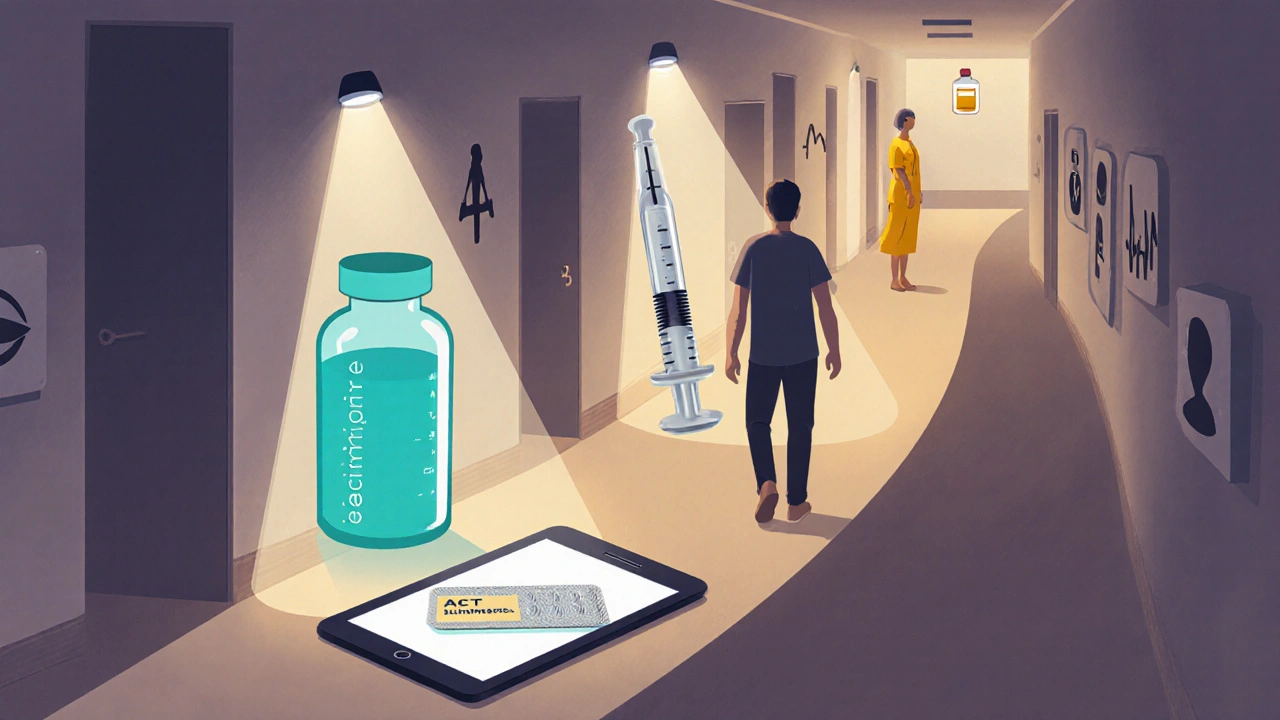Hydroxychloroquine vs Alternatives: Benefits, Risks & Best Uses
 Oct, 4 2025
Oct, 4 2025
Hydroxychloroquine vs Alternatives: Decision Guide
Key Takeaways
- Hydroxychloroquine is an antimalarial and immunomodulatory drug widely used for lupus and rheumatoid arthritis.
- Its main alternatives differ by indication: chloroquine and artemisinin‑based therapies for malaria, methotrexate and belimumab for autoimmune disease, and azithromycin or doxycycline for certain infections.
- When judging efficacy, look at clinical trial data, disease‑specific outcomes, and real‑world prescribing patterns.
- Safety profiles vary: hydroxychloroquine has a lower cardiac risk than chloroquine but can cause retinal toxicity with long‑term use.
- Cost and availability in the UK NHS influence the practical choice for most patients.
What Is Hydroxychloroquine?
Hydroxychloroquine is a synthetic 4‑aminoquinoline that was first approved in the 1950s as a malaria prophylactic. It works by increasing the pH of intracellular vesicles, which interferes with parasite growth and modulates immune cell signaling. In the United Kingdom it is also licensed for systemic lupus erythematosus (SLE) and rheumatoid arthritis (RA) because of its ability to dampen auto‑inflammatory pathways.
How Hydroxychloroquine Works and When It’s Used
The drug accumulates in lysosomes and endosomes, raising their pH and preventing the malaria parasite Plasmodium falciparum from digesting hemoglobin. In autoimmune disorders it blocks Toll‑like receptor activation, reducing cytokine release.
Typical adult dosing for SLE is 200-400mg daily, with a half‑life of about 40days, allowing steady‑state concentrations after 2-3months. For malaria prophylaxis the regimen is 400mg once weekly after a loading dose.
Alternatives to Hydroxychloroquine
Choosing an alternative depends on the disease you’re treating. Below are the most common substitutes, each introduced with a brief definition.
Chloroquine is a close chemical cousin of hydroxychloroquine, historically the first‑line malaria drug before resistance spread. It shares the same lysosomal‑pH mechanism but carries a higher risk of cardiotoxicity and visual disturbances.
Artemisinin‑based Combination Therapy (ACT) combines a fast‑acting artemisinin derivative with a partner drug (e.g., lumefantrine) to clear P. falciparum infections. ACTs are the WHO‑recommended first‑line treatment for uncomplicated malaria worldwide.
Methotrexate is a folate antagonist that inhibits dihydrofolate reductase, reducing DNA synthesis in rapidly dividing immune cells. It is the cornerstone disease‑modifying antirheumatic drug (DMARD) for RA and is used off‑label for severe SLE.
Belimumab is a monoclonal antibody that blocks the B‑lymphocyte stimulator (BLyS) protein, decreasing auto‑antibody production. Approved for SLE in patients who remain active despite standard therapy.
Azithromycin is a macrolide antibiotic often paired with hydroxychloroquine in early COVID‑19 studies, though later data showed limited benefit. It remains useful for atypical bacterial pneumonia and some sexually transmitted infections.
Doxycycline is a tetracycline antibiotic that also serves as a malaria chemoprophylactic for travelers to regions with chloroquine‑resistant strains. It works by inhibiting protein synthesis in the parasite.

Side‑by‑Side Comparison
| Drug | Primary Indication | Mechanism | Typical Adult Dose | Half‑Life | Common Side Effects | UK Cost (per month) |
|---|---|---|---|---|---|---|
| Hydroxychloroquine | Malaria prophylaxis, SLE, RA | Raises lysosomal pH; modulates Toll‑like receptors | 200‑400mg daily (SLE/RA) or 400mg weekly (malaria) | ~40days | Retinal toxicity (long term), GI upset, mild QT prolongation | ≈£6-£12 |
| Chloroquine | Malaria treatment/prophylaxis | Similar lysosomal pH increase | 500mg twice daily for treatment | ~1-2days | Retinal toxicity (higher risk), cardiomyopathy, hypoglycemia | ≈£3-£5 |
| Artemisinin‑based Combination Therapy | Uncomplicated P. falciparum malaria | Rapid parasite clearance via free‑radical generation | Artemether‑lumefantrine 4 tablets twice daily for 3days | ~1hour (artemisinin) / 3‑5days (partner) | Headache, dizziness, nausea | ≈£10-£15 |
| Methotrexate | RA, severe SLE, psoriasis | Folate pathway inhibition, reduces DNA synthesis in immune cells | 7.5‑25mg weekly orally or subcutaneously | ~3-10hours | Liver enzyme elevation, cytopenias, mucosal ulcers | ≈£4-£8 |
| Belimumab | Active SLE | BLyS inhibition, reduces auto‑antibody production | 10mg/kg IV on days0,14,28 then every 28days | ~2weeks (biologic clearance) | Infusion reactions, nausea, infections | ≈£300‑£350 (per infusion) |
When to Choose Hydroxychloroquine Over Its Alternatives
If you or your clinician are dealing with a chronic autoimmune disease and need a low‑cost oral agent, hydroxychloroquine often wins because it has a favorable safety record for long‑term use and requires only simple blood monitoring for retinal health.
For acute malaria in regions where chloroquine resistance is high, ACTs are the gold standard. Chloroquine might still be useful for P. vivax in areas without resistance, but the cardiac and visual safety signals push most prescribers toward ACTs or hydroxychloroquine prophylaxis when travel is short‑term.
In severe SLE that does not respond to hydroxychloroquine and methotrexate, biologics like belimumab become cost‑effective despite the high price tag because they can dramatically cut flare rates.
Monitoring and Safety Tips
- Eye exams: Baseline retinal screening and annual OCT scans after five years of use (or sooner if high daily doses).
- Cardiac checks: Baseline ECG if you have a history of arrhythmia or are taking other QT‑prolonging drugs.
- Blood work: Liver function and complete blood count every 3‑6months for autoimmune dosing.
- Drug interactions: Avoid concurrent use of strong CYP2D6 inhibitors that can raise hydroxychloroquine levels.
Practical Decision Tree
- Identify the primary condition (malaria, SLE, RA, other).
- If malaria:
- Check local resistance patterns. If P. falciparum resistance is high → choose ACT.
- If traveling to chloroquine‑sensitive area → chloroquine or hydroxychloroquine prophylaxis.
- If autoimmune disease:
- Start with hydroxychloroquine for mild‑to‑moderate SLE/RA.
- Escalate to methotrexate if disease activity persists.
- Consider belimumab or other biologics for refractory SLE.
- Assess patient‑specific factors: kidney function, ophthalmic health, pregnancy status, cost constraints.
Frequently Asked Questions
Can hydroxychloroquine prevent COVID‑19?
Large randomized trials published after 2021 showed no meaningful reduction in infection risk or severe outcomes. Health agencies, including the UK’s MHRA, no longer recommend it for COVID‑19 prophylaxis.
What’s the biggest safety concern with long‑term hydroxychloroquine?
Retinal toxicity can develop after five or more years of daily use, especially at doses >5mg/kg/day. Regular ophthalmic exams are essential to catch early changes.
Is chloroquine still used for malaria in the UK?
Only in parts of the world where P. vivax remains chloroquine‑sensitive. In the UK, travel clinics default to ACTs for most destinations.
How does methotrexate compare cost‑wise?
Methotrexate is cheaper than biologics, costing about £4‑£8 per month on the NHS, but it requires more intensive blood monitoring than hydroxychloroquine.
Can I take hydroxychloroquine with azithromycin?
Both drugs can prolong the QT interval. Combining them should only happen under cardiac monitoring, and it’s generally avoided unless a clinician deems the benefit outweighs the risk.

Next Steps for Readers
1. Talk to your GP or rheumatologist about whether hydroxychloroquine fits your disease profile.
2. If traveling to a malaria‑endemic region, schedule an appointment with a travel clinic to get the most up‑to‑date resistance map.
3. Arrange baseline eye testing if you plan to be on hydroxychloroquine for more than a year.
4. Keep a written list of all medicines you take; share it with any specialist prescribing a new alternative.
Making an informed choice now can keep you well‑treated and avoid costly side‑effects later.
Mark Eaton
October 4, 2025 AT 15:17Great rundown on hydroxychloroquine and its alternatives! If you're starting on HCQ for lupus or RA, remember the baseline eye exam and the annual OCT after five years. Keep your dosage under 5 mg/kg/day to minimize retinal risk. Pair the medication with a simple blood work schedule: liver enzymes and CBC every 3‑6 months. And don’t forget that adherence is key – missing doses can lead to flare‑ups, so set a reminder.
Alfred Benton
October 8, 2025 AT 03:17It is academically indefensible to accept the mainstream narrative that hydroxychloroquine is merely a benign immunomodulator. The pharmaceutical conglomerates have crafted a veneer of safety while obfuscating long‑term retinal toxicity data that predate the pandemic. Moreover, the rapid regulatory endorsement for COVID‑19 prophylaxis was a calculated maneuver to expand market share, exploiting public fear. Independent studies, often suppressed, reveal a statistically significant increase in cardiac arrhythmias when combined with other QT‑prolonging agents. The cost‑effectiveness argument neglects the hidden societal expense of vision loss. One must also consider the ethical implications of prescribing a drug with a half‑life of forty days, which effectively locks a patient into a prolonged exposure without adequate informed consent. The mechanistic similarity to chloroquine, a compound with known cardiomyopathy risk, should raise red flags. In regions where chloroquine resistance is documented, the switch to ACTs is not merely a recommendation but a public health imperative. Yet, the subtle pivot toward hydroxychloroquine prophylaxis in travel clinics reflects a deeper alignment with profit‑driven agendas rather than evidence‑based practice. The selective citation of favorable trials, while ignoring dissenting data, betrays a systematic bias. Regulatory bodies, under pressure from lobbying groups, have streamlined approval pathways, sacrificing rigorous post‑marketing surveillance. The alleged “favorable safety profile” is, at best, a marketing slogan, not a scientific verdict. As vigilant clinicians, we must demand full transparency and prioritize patient autonomy above corporate interests. Only through rigorous scrutiny can we hope to untangle the web of misinformation that currently surrounds this drug.
Susan Cobb
October 11, 2025 AT 15:17The comparative matrix appears exhaustive, yet it glosses over the nuanced pharmacokinetic interactions that are pivotal for optimal therapeutic decision‑making. One must weigh the stochastic variability in patient metabolism before defaulting to HCQ. Elegance lies in tailoring therapy to the individual.
Ivy Himnika
October 15, 2025 AT 03:17Thank you for the comprehensive tables; they are exceptionally clear. 😊 The inclusion of cost data enhances clinical applicability.
Nicole Tillman
October 18, 2025 AT 15:17When we contemplate drug selection, it becomes a meditation on risk versus reward, a balance echoing the ancient scales of justice. Each alternative carries its own ethical weight, compelling us to honor the patient's lived experience while remaining grounded in empirical evidence.
Jason Ring
October 22, 2025 AT 03:17i think the table is helpful but some of the side effect list looks a bit off. also, cost can vary a lot dependin on insurance. just a thought.
Kelly Hale
October 25, 2025 AT 15:17Patriots of medicine must stand resolute against the insidious encroachment of foreign pharmaceutical interests that seek to dictate our therapeutic choices. Hydroxychloroquine, a home‑grown staple, embodies the spirit of self‑reliance that our nation cherishes. The alternative regimens, imported and overpriced, threaten to erode our sovereignty over health decisions. Let us champion the drug that has served our troops abroad and our citizens at home, rejecting the elitist push for exotic ACTs unless absolutely necessary. The cost savings alone represent a reclamation of fiscal responsibility for the American people. Moreover, deploying HCQ responsibly underscores our commitment to evidence‑based patriotism, not blind allegiance to multinational conglomerates. In these turbulent times, confidence in a domestically trusted medication bolsters national morale. So, when you weigh your options, remember the emblematic value of supporting home‑grown solutions.
Neviah Abrahams
October 29, 2025 AT 03:17the data is solid but the presentation could use more visuals the tables are dense
Uju Okonkwo
November 1, 2025 AT 15:17Hey folks, great discussion! If you're new to HCQ, remember to schedule that baseline eye exam-prevention is better than cure. And for anyone traveling, a quick chat with a travel clinic can tailor the best prophylaxis for your destination.
allen doroteo
November 5, 2025 AT 03:17Hydroxychloroquine costs less than belimumab.
Corey Jost
November 8, 2025 AT 15:17The decision matrix you’ve assembled is undoubtedly comprehensive, yet I can’t help but question whether the sheer volume of data may overwhelm clinicians who seek swift, actionable insights. In practice, physicians often operate under time constraints that demand concise recommendations rather than exhaustive tables. Therefore, a tiered approach-highlighting first‑line agents with clear indications-might serve the pragmatic needs of the bedside more effectively. Additionally, the cost landscape in the UK NHS can shift rapidly; ongoing negotiations with pharmaceutical suppliers may render the price brackets fluid. It would be beneficial to embed a disclaimer about potential variance. A separate section for monitoring protocols, perhaps delineated by drug class, could further streamline decision‑making. Moreover, the inclusion of patient‑reported outcomes could enrich the comparative analysis, providing a human dimension to the pharmacologic data. One could also argue for an interactive decision‑tree algorithm that dynamically adjusts recommendations based on patient comorbidities. Overall, the foundation is solid, but refining the presentation for clinical usability would elevate its impact.
Nick Ward
November 12, 2025 AT 03:17Appreciate the thoroughness, especially the eye‑exam guidance 😊. It’s the practical tips that make the difference.
felix rochas
November 15, 2025 AT 15:17Let us be crystal clear, the suppressed data, the hidden side‑effects, the collusion-all point to a massive cover‑up!; you cannot trust the mainstream narrative, the truth is being buried, period.
inder kahlon
November 19, 2025 AT 03:17From a pharmacology standpoint, HCQ’s lysosomal pH elevation is modest compared to chloroquine, which explains its safer cardiac profile. For most patients, the risk‑benefit balance still favors HCQ as first‑line for SLE.
Dheeraj Mehta
November 22, 2025 AT 15:17Love the clear tables! 😊 Keep the optimism alive-good decisions start with good info.
Oliver Behr
November 26, 2025 AT 03:17The cultural context of drug use varies globally, and that’s worth noting.
Tiffany W
November 29, 2025 AT 15:17From a pharmacoeconomic perspective, the incremental cost‑effectiveness ratio (ICER) of HCQ vs. biologics is markedly favorable, underscoring its position in the therapeutic algorithm.
Rajeshwar N.
December 3, 2025 AT 03:17The comparative safety profile aligns with the mechanistic pathways outlined; however, real‑world adherence data suggest a gap between efficacy and effectiveness. Future analyses should incorporate longitudinal surveillance to capture this nuance.
Louis Antonio
December 6, 2025 AT 15:17Honestly, the hype around HCQ was overblown, but it still has a place for some auto‑immune cases. Just don’t expect miracles.